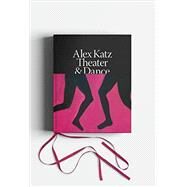Alex Katz: Theater & Dance
, by Reinhart, Charles L.; Salle, David; Storr, Robert; Tipton, Jennifer; Tuite, Diana- ISBN: 9780847871469 | 0847871460
- Cover: Hardcover
- Copyright: 10/11/2022
Alex Katz's long-standing fascination with dance and collaborations with renowned playwrights and choreographers yielded some of his most complex compositions.
Since Alex Katz first painted the Paul Taylor in 1959, he has invited dancers to model for him. Dance, according to the artist, belongs to the same “long tradition of gestures” as painting. This publication is the first to examine the many decades of Katz’s work for the stage, including the ways that he introduced tenets of postwar painting into theater and dance aesthetics.
“I’d never seen anything like it,” Katz recalls of his first encounter with the work of dancer and choreographer Paul Taylor. The two partnered on fifteen productions for which Katz innovated with flat lighting, humorous obstacles, and framing mechanisms. His involvement with Paul Taylor led to collaborations with other companies including Yoshiko Chuma, Laura Dean, William Dunas, and Parsons.
Among Katz’s most celebrated sets is the ensemble of cutouts he created for Kenneth Koch’s 1961 production, George Washington Crossing the Delaware. Katz heightened the absurdity of the Revolutionary War-inspired play with Pop-adjacent figures and props. This publication brings together paintings, sketches, costumes, photographs, film stills, and ephemera. Newly-commissioned essays, unpublished materials, and major paintings will provide an overview of Katz's working relationships with individual choreographers and shed new light on avant-garde collaborations in New York between the 1960s and 80s.
Since Alex Katz first painted the Paul Taylor in 1959, he has invited dancers to model for him. Dance, according to the artist, belongs to the same “long tradition of gestures” as painting. This publication is the first to examine the many decades of Katz’s work for the stage, including the ways that he introduced tenets of postwar painting into theater and dance aesthetics.
“I’d never seen anything like it,” Katz recalls of his first encounter with the work of dancer and choreographer Paul Taylor. The two partnered on fifteen productions for which Katz innovated with flat lighting, humorous obstacles, and framing mechanisms. His involvement with Paul Taylor led to collaborations with other companies including Yoshiko Chuma, Laura Dean, William Dunas, and Parsons.
Among Katz’s most celebrated sets is the ensemble of cutouts he created for Kenneth Koch’s 1961 production, George Washington Crossing the Delaware. Katz heightened the absurdity of the Revolutionary War-inspired play with Pop-adjacent figures and props. This publication brings together paintings, sketches, costumes, photographs, film stills, and ephemera. Newly-commissioned essays, unpublished materials, and major paintings will provide an overview of Katz's working relationships with individual choreographers and shed new light on avant-garde collaborations in New York between the 1960s and 80s.







